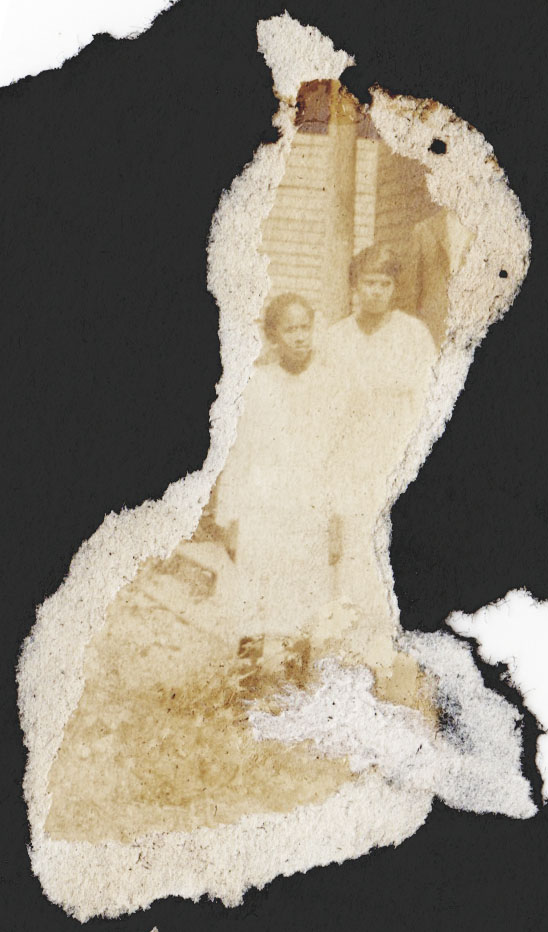 This bit of photograph was under another photograph in my Graham grandparent’s Black Album. Unfortunately, I did not make a note of the photograph that I pried off of this one years ago. Ah, the mistakes I made back then.
This bit of photograph was under another photograph in my Graham grandparent’s Black Album. Unfortunately, I did not make a note of the photograph that I pried off of this one years ago. Ah, the mistakes I made back then.



 It’s been hard for me to get into the Christmas spirit this year. Everyday seems to bring some new report of violence, both here and around the world. This years offering for Footnote Maven’s Blog Caroling is Silent Night sung by Sweet Honey in the Rock. It combines a version of the carol combined with pictures of the demonstrations that have swept the nation after the police actions in Ferguson, MO and New York. May next Christmas find us closer to true Justice for all in this country and Peace around the world.
It’s been hard for me to get into the Christmas spirit this year. Everyday seems to bring some new report of violence, both here and around the world. This years offering for Footnote Maven’s Blog Caroling is Silent Night sung by Sweet Honey in the Rock. It combines a version of the carol combined with pictures of the demonstrations that have swept the nation after the police actions in Ferguson, MO and New York. May next Christmas find us closer to true Justice for all in this country and Peace around the world.
 I have looked for the original article about the death of Samuel Cleage in 1850 with no results, other than this short item. After reading the obituary, I noticed the following items along with ads for ink, land, “newest goods” and the Forest Hill Academy. There was an article about the new President Filmore and the ads below, which jumped out at me.
I have looked for the original article about the death of Samuel Cleage in 1850 with no results, other than this short item. After reading the obituary, I noticed the following items along with ads for ink, land, “newest goods” and the Forest Hill Academy. There was an article about the new President Filmore and the ads below, which jumped out at me.
The newspaper came from this site Library of Congress Historical Newspapers, The Athens Post.
Chancery Sale of 22 Negroes
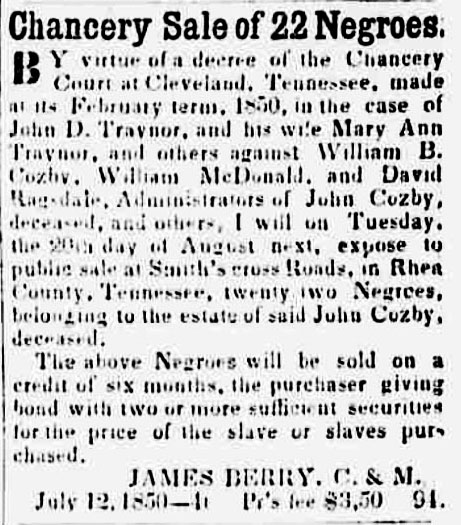
“By virtue of a decree of the chancery court at Cleveland, Tennessee made at __ February term, 1850 in the case of John D. Traynor and his wife Mary Ann Traynor and others against William B. Cozby, William McDonald and David Ragsdale Administrators of John Cozby deceased and others. I will on Tuesday, the 20th day of August next, expose to public sale at Smith’s cross Roads, in Rhea County, Tennesseem twenty two Negroes belonging to the estate of said John Cozby, deceased.
The above Negroes will be sold on a credit of six months the purchaser giving bond with two or more suffcient securities for the price of the slave or slaves purchased. James Berry C. & M. July 12, 1850 – 4 Pr’s fee $3.50 94.”
A Likely Negro Girl for Sale!
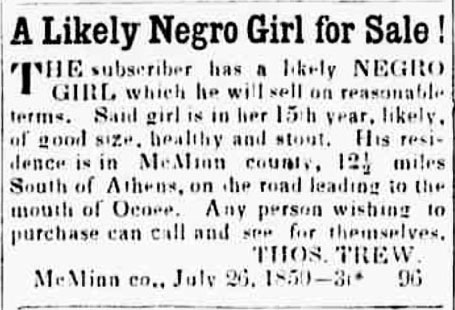 The subscriber has a likely NEGRO GIRL which he will sell on reasonable terms. Said girl is in her 15th year, likely, o good size, healthy and stout. His residence is in McMinn county, 12 1/2 miles South of Athens on the road leading to the mouth of Ocoee. Any person wishing to purchase can call and see for themselves Thos. Trew McMinn co., July 26, 1850 – 3 96
The subscriber has a likely NEGRO GIRL which he will sell on reasonable terms. Said girl is in her 15th year, likely, o good size, healthy and stout. His residence is in McMinn county, 12 1/2 miles South of Athens on the road leading to the mouth of Ocoee. Any person wishing to purchase can call and see for themselves Thos. Trew McMinn co., July 26, 1850 – 3 96
Run Away
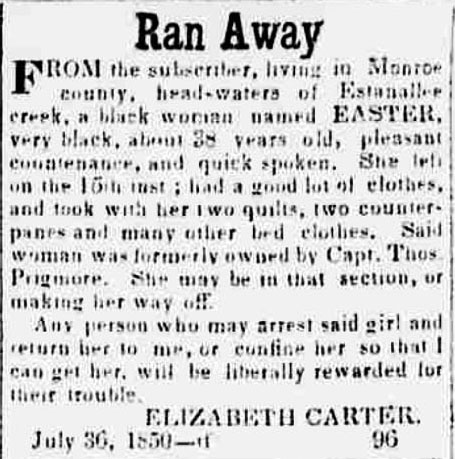 “From the subscriber living in Monroe county, head-waters of Estanallee creek, a black woman named EASTER, very black, about 38 years old, pleasant countenance, and quick spoken. She left on the 15th last; had a good lot of clothes, and took with her two quilts, two counterpanes and many other bed clothes. Said woman was formerly owned by Capt. Thos. Pagmore. She may be in that section or making her way off.
“From the subscriber living in Monroe county, head-waters of Estanallee creek, a black woman named EASTER, very black, about 38 years old, pleasant countenance, and quick spoken. She left on the 15th last; had a good lot of clothes, and took with her two quilts, two counterpanes and many other bed clothes. Said woman was formerly owned by Capt. Thos. Pagmore. She may be in that section or making her way off.
Any person who may arrest said girl and return her to me, or confine her so that I can get her will be liberally rewarded for their trouble. ELIZABETH CARTER, July 30, 1850- 96″
Samuel Cleage was the owner of my 2 X great grandfather, Frank Cleage. In July of 1850, Samuel Cleage was killed by Ambrose Griffith. Unfortunately the only information that I have is a very splochy xerox copy of an article from (I think) a 1850 Athenian Post. I do not have the previous article that talks about the reason for the argument that led to the murder. I looked for Ambrose Griffith in the 1840 and 1850 and 1860 census. The only person by that name was a young man born in 1842 (too young to have been the murderer.) In 1860 he was overseer for Samuel Cleage’s son, David.
After Samuel’s death, my great grandfather, Frank ended up with Samuel’s other son, Alexander. He was mentioned in these three documents: A letter to the overseer from Samuel Cleage in 1834, Bill of sale from David to Alexander Cleage in 1852, The Will of Alexander Cleage in 1860.


“In the last issue of our paper appeared an account of a difficulty between Samuel Cleage and Ambrose Griffith in which the former was cut and stabbed by the latter. This occurred on the morning of the 17th June. Sam Cleage died of his wounds the following Saturday night. The funeral sermon was preached on the succeeding Monday by the Rev. J.H. Martin at Mars Hill Presbyterian Church, Athens of which the deceased was a member. His friends who were with him in his last hours state that he was conscious of his dying condition and full of hope – even forgiving(?) the miserable man who’s fatal act was depriving a stricken wife and _____ children of their natural protector. We are __________ with him ___ and_____ was regarded him as ________ Since his connection with the church which occurred seven years ago, his walk had been consistent with _____ actions. The widow and the ______ children ___ the ___ this afternoon that was___upon them.
It is said that Griffith remained secreted in the neighborhood until he learned that Cleage was dying and then fled the country. We are not advised whether any steps are being taken to have him captured and brought to ______ for his crime. This is the fourth murder committed within the last two or three years – two in this town and two in the immediate vicinity- and in neither case has any vigorous or well directed effort been made to bring the murderer to the seat (?) of justice. Here as elsewhere the community is horrified at such things for a day or two and then drops into stolid indifference until startled(?) by the announcement of another bloody tragedy. It is so all over the United States. Punishment for crime of the higher grade is the exception and immunity the rule and the fault rests not with the officers of the law, but a demoralized and degenerate public sentiment which hunts down and sends a petty thief to the penitentiary and lets the red handed murderer escape without an effort.”

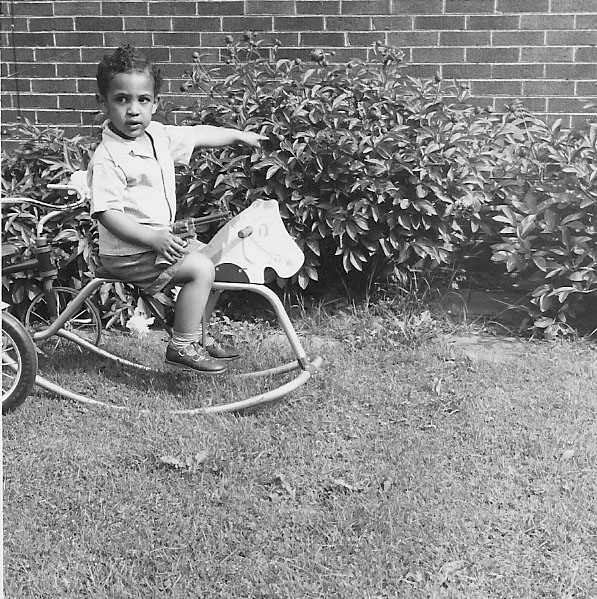

Another post about Cousin Ernest – What Is Ernest Doing Now?
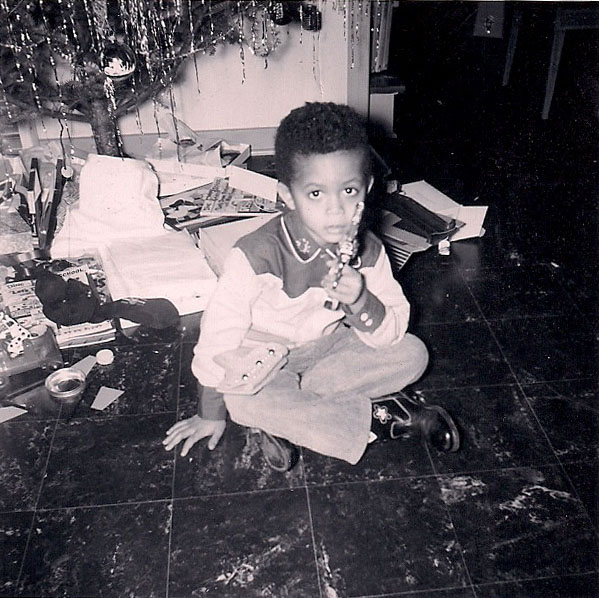
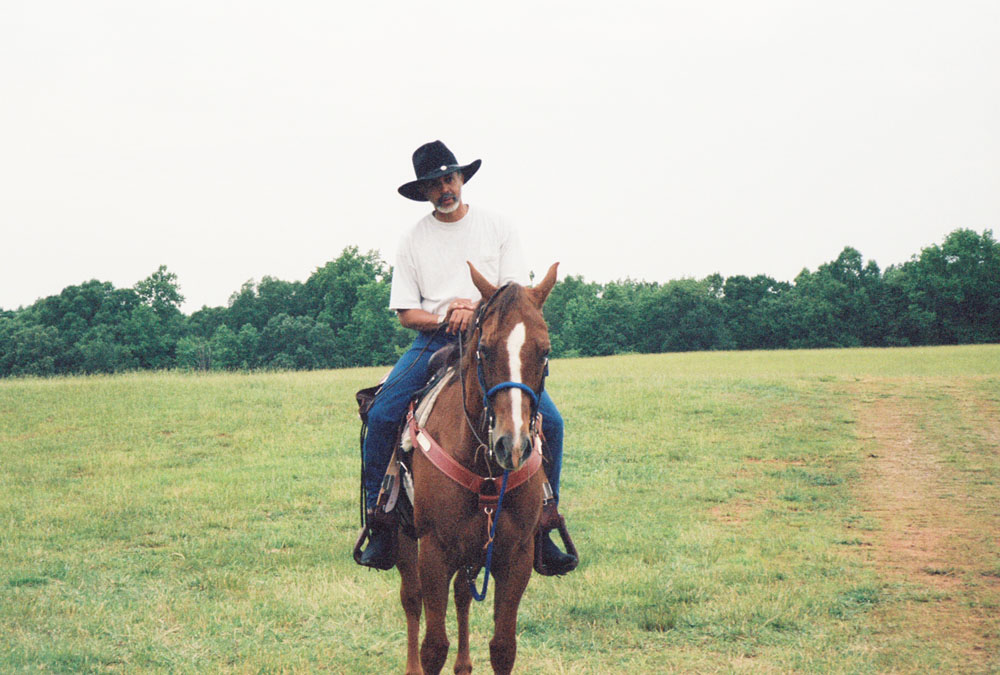
Other posts about Cousin Warren – Warren’s Christmas Birthday Party, Warren Evens, Then and Now, A Silhouette of Cousin Warren

 This post was inspired by a prompt from The Book of Me Written By You ongoing Challenge organized by Julie Goucher at the blog, Angler’s Rest.
This post was inspired by a prompt from The Book of Me Written By You ongoing Challenge organized by Julie Goucher at the blog, Angler’s Rest.
 My life is divided into Sections and chapters. Places and age. Births and deaths. Children and events. Sickness and travel. There is a prequel. There will be an afterward.
My life is divided into Sections and chapters. Places and age. Births and deaths. Children and events. Sickness and travel. There is a prequel. There will be an afterward.
Chapters blend and blur. What used to stand out, bleeds into other chapters, reappears later as a footnote. Some things weave throughout the chapters – church, family, children, moving.
I am using this post to organize posts I’ve written about my life events. Click on the links and you will go to the post about the place or person mentioned.
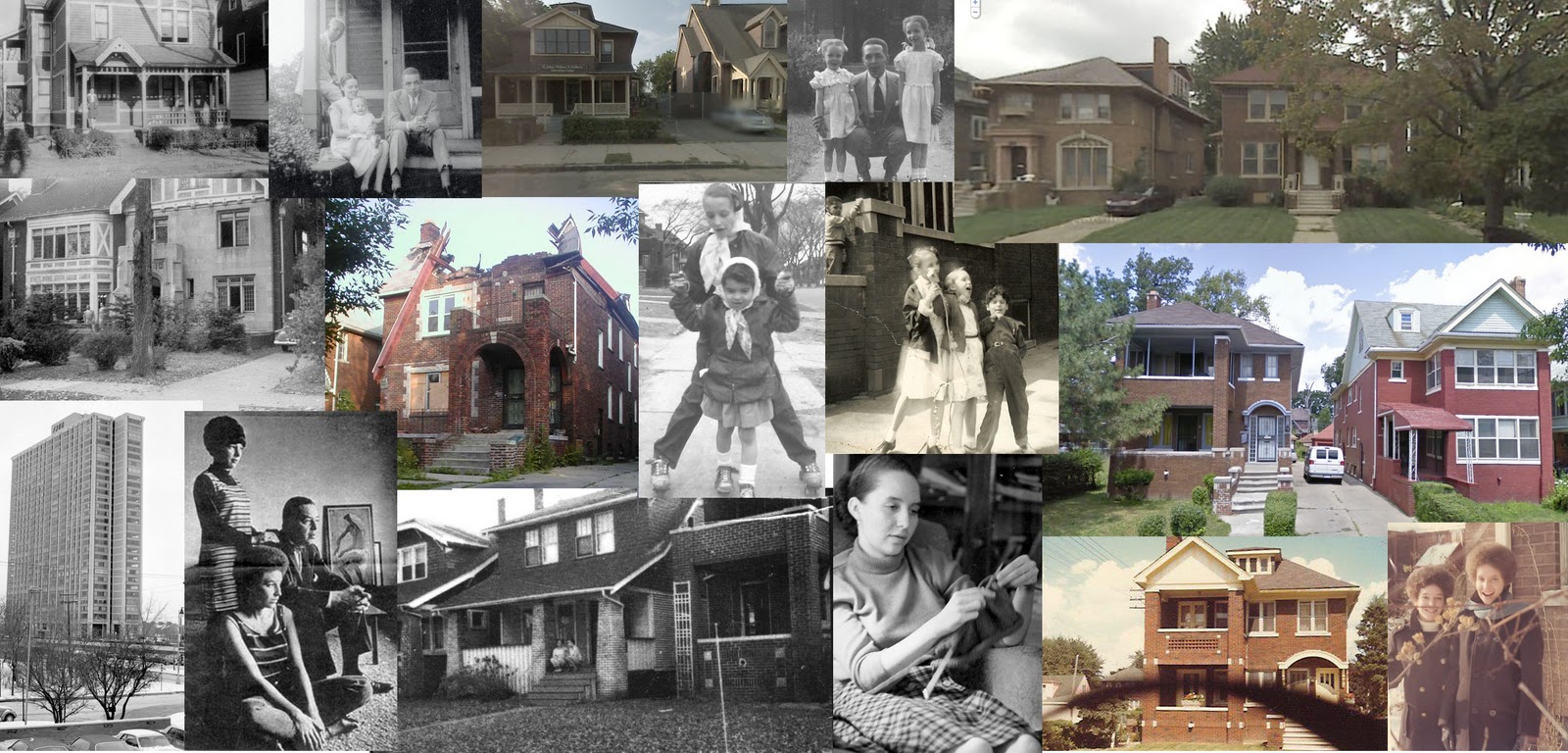 The book begins in Springfield, Mass. I was born. My sister was born. We moved to Detroit.
The book begins in Springfield, Mass. I was born. My sister was born. We moved to Detroit.
In Detroit, we lived on Atkinson. I started school. We moved from Atkinson to Chicago Blvd. I changed schools from Brady to Roosevelt. My mother became a teacher. My great grandmother Jennie died. My parents divorced. We moved from Chicago Blvd. to Calvert. Started Durfee. Divide this section into 3 chapters based on Streets.
Atkinson. Started school. Lived down the street from both my father’s church on 12th and my Cleage grandparents. Saturdays at my Graham grandparents. Teaching Pearl to read. Pneumonia. Dogs.
Chicago Blvd. Living in the church house. That covers a lot right there. Piano lessons. rollar skating. Sore throats. Chicken pox. Tonsils removed. Great grandmother Turner dies. Cousins Jan and Marilyn born. Parents divorce.
Calvert. Toni’s school of dance arts. Neighborhood kids and games. Best friend. Youth fellowship. piano lessons. Being a part of and then being outside of. Measles. Grandfather dies. Aunt Daisy dies.
Oregon. On the outside, making plans. 1 year at McMichael Jr. High. My mother married Henry. Northwestern High School. Swim team. Graduated and went to Wayne State. Aunt Abbie dies. Met Jim. That has to start a new chapter.
Went to Wayne State. Met Jim. Printmaking. Drawing. Groups. Publications. Demonstrations. Love. Broken heart. Loneliness. Detroit riot. Moving from Oregon to Fairfield. Graduated from college. Cross country tour. Return home. Maybe Fairfield should be combined with “Went to Wayne.” I lived there so short a time. Yes, combine. San Francisco, New York, return to Detroit.
Moving out. Black Conscience Library. House on N. Martindale. Sewing Factory. Jim. Getting pregnant. Moving. Jilo’s birth. Moving again and again and again. Moving to Brewster projects. Teaching at Merrill Palmer. Getting pregnant again. Moving to Atlanta.
Atlanta. Working at The Institute of the Black World. Martin Luther King preschool. Ife born. Jim working at the Atlanta Voice. Staying home with the 2 children. Nanny and Poppy die.
The Emergency Land Fund. Jim’s job. Moving to SC. Isolation! Getting pregnant. Moving to Simpson County, MS. Birth of Ayanna. Goats and chickens. Moving to St. John’s Road. Various jobs Jim had during that time. Birth of Tulani and James. Move to Excelsior Springs, MO. Jilo, Ife and Ayanna start school. My mother died. Jim’s mother died. My grandmother died. Norway. 4-H Club.
Excelsior Springs MO. Job corps, paper routes, St. Ann’s church. Food Co-op. Altar Society. Schools. Tulani starts kindergarden. Jean, Monette and Raymond in KC. Reunions. Community Theater. Adoption Dolls. Moving to Idlewild, MI.
Idlewild, MI. Jim with MDOT. Cabral joins the family. Henry and other members of the Cleage side are close. Local schools bad. Jilo goes to college. Homeschooling. Interlochen. gardening. Wood heat. The lake. Ife goes to college. Jim’s father dies. Louis dies. Henry dies. Ayanna moves to Atlanta. Tulani goes to college. James goes to college. Abeo born. Tatayana born. Jilo moves to Idlewild. My father dies. Osaze born. Kylett born. People continue to move away and back and to different places. Hasina born. Sean and Sydney born. Cabral moves to Atlanta. We move to Henry’s house. Move to Atlanta.
Atlanta. Family, family and more family. Printmaking. Blogging. Plays. Ballet. Growing old.

This is a copy of a companion Bill of Sale to the one that conveyed my 2 X great grandfather Frank Cleage from David Cleage, Walter Nutter and Elizabeth H. Nutter to Alexander Cleage. After the death of Samuel Cleage, father of David, Elizabeth and Alexander, died there was some shuffling around of enslaved people, livestock and household property between the sibling. In each document 12 slaves and the same amount of money are exchanged. This is one of three Bills of Sale that I have of those transactions. It is transcribed below. As always, click on them to enlarge. There was no punctuation in the document and I added none.

Know all men by these presents that we Alexander Cleage and Walter Nutter and his wife Elizabeth H Nutter have this day bargained and sold to David Cleage and his heirs and assigns forever Charity fourteen, Caroline sixteen Jim thirty Joe eight Sally near ten Arch sixteen Margth fourteen Bill forty five Charles twenty four Mary thirty one Henry four Lydia one year of age
For five thousand two hundred and fifty dollars being his distribution share out of the proceeds of the slaves of Samuel Cleage deceased We warrant said negroes (sic) to be slaves for life and that we as the heirs at law of Samuel Cleage have a right to convey them
Given under our hands and seals this 20th day of March 1852
Witness
Sam H Jordon Alex Cleage
Geo W Mayo Walter Nutter
Elizabeth H Nutter
State of Tennessee
County of McMinn
Personally appeared before me Geo W Mayo clerk of the county court of said county Alexander Cleage Walter Nutter and Elizabeth H Nutter wife of said Nutter the bargainers to the above bill of sale with whom I am personally acquainted each of whom acknowledge the due execution of the same on the day and year it bears date and for the purpose therein expressed and that the said Elizabeth Nutter wife of the aforementioned Walter Nutter was by me examined privately and apart from her said husband Walter Nutter who declared that she executed same knowingly & free from any compulsion or restraint on the part of her said husband Walter Nutter
Given under my hand at office in Athens the 20th day of March 1852
Geo W Mayo clerk
Bill of Sale
Alex Cleage
Walter Nutter
Elizabeth H Nutter
to
David Cleage
This is a copy of the Bill of Sale that conveyed my 2 X great grandfather Frank Cleage from David Cleage, Walter Nutter and Elizabeth H. Nutter to Alexander Cleage. After the death of Samuel Cleage, father of David, Elizabeth and Alexander, died there was some shuffling around of enslaved people, livestock and household property between the siblings. This is one of three Bills of Sale that I have of those transactions. The documents are transcribed below. As always, click on them to enlarge. There was no punctuation in the document and I added none.
Know all men by these presents that we David Cleage and Walter Nutter and his wife Elizabeth H Nutter have this day bargained and sold to Alexander Cleage and his heirs and assigns forever Joe forty four years of age Jane eighteen Lynd eleven Frank thirty nine Phillip forty Lewis twenty six Sam ten Jeff five Martha twenty one Lea thirty four Julian forty three Patsy five
For five thousand two hundred and fifty dollars being his distribution share out of the proceeds of the slaves of Samuel Cleage deceased We warrant said negroes (sic) to be slaves for life and that we as the heirs at law of Samuel Cleage have a right to convey them
Given under our hands and seals this 20th day of March 1852
Witness
Sam H Jordon David Cleage
Geo W Mayo Walter Nutter
Elizabeth H Nutter
State of Tennessee
County of McMinn
Personally appeared before me Geo W Mayo clerk of the county court of said county David Cleage Walter Nutter and Elizabeth H Nutter wife of said Nutter the bargainers to the above bill of sale with whom I am personally acquainted each of whom acknowledge the due execution of the same on the day and year it bears date and for the purpose therein expressed and that the said Elizabeth Nutter wife of the aforementioned Walter Nutter was by me examined privately and apart from her said husband Walter Nutter who declared that she executed same knowingly & free from any compulsion or restraint on the part of her said husband Walter Nutter
Given under my hand at office in Athens the 20th day of March 1852
Geo W Mayo clerk
Bill of Sale
David Cleage
Walter Nutter
Elizabeth H Nutter
to
Alex Cleage

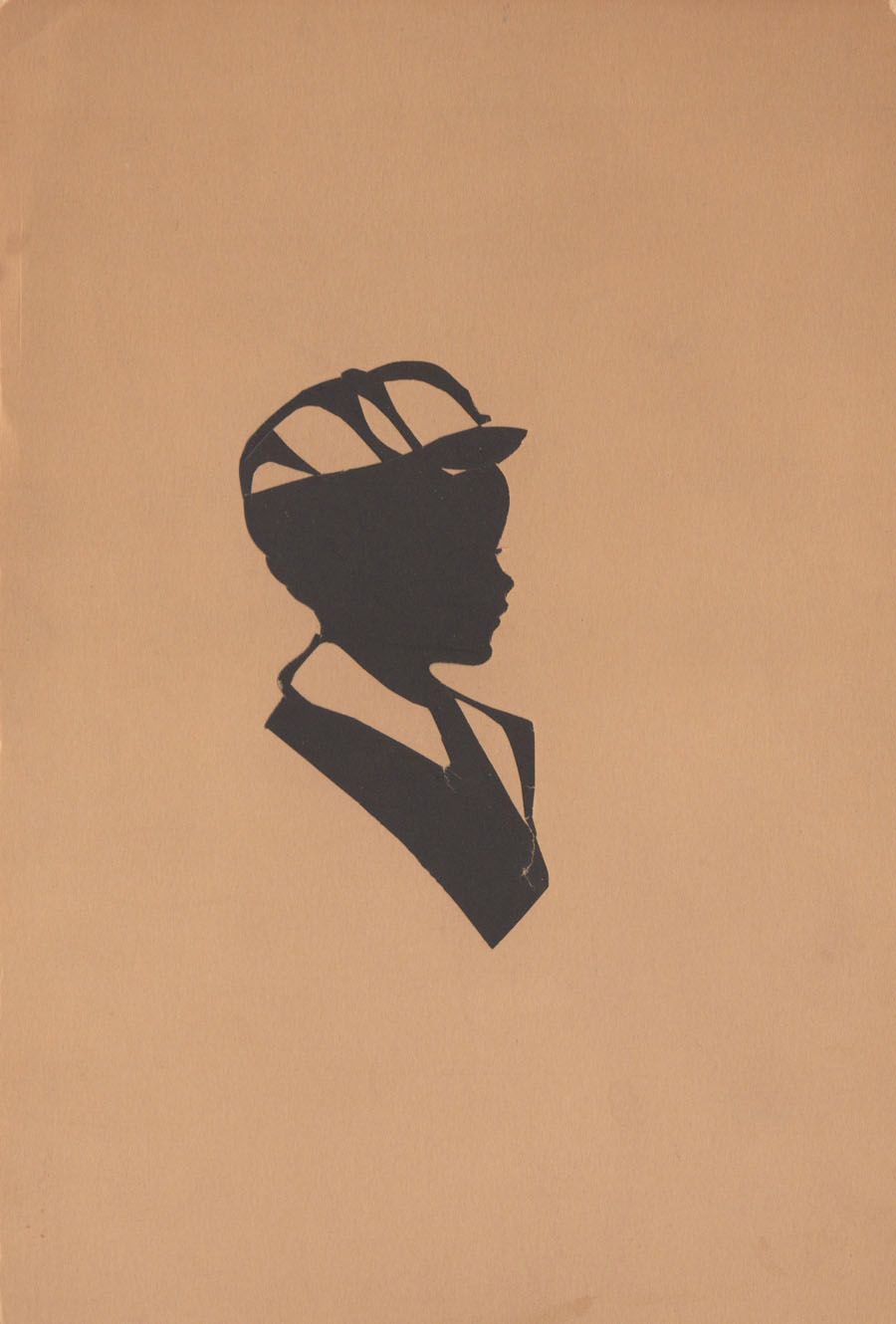 Here is a silhouette of my cousin Warren Evans in about 1951. He was born in 1948 and looks about 3 to me. I don’t know who did the cutting, as there is no signature.
Here is a silhouette of my cousin Warren Evans in about 1951. He was born in 1948 and looks about 3 to me. I don’t know who did the cutting, as there is no signature.
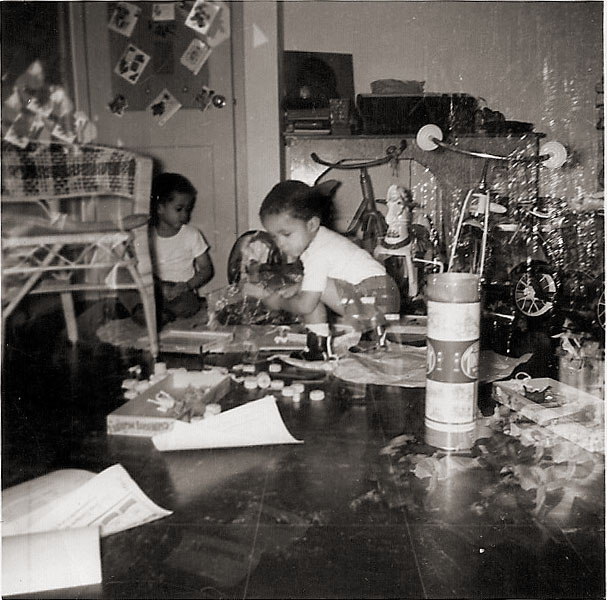
Fast Forwarding to November 2014 Warren Evans was elected Wayne County CEO with 72% of the vote.
Earlier posts about Warren: Warren Evans – Then and Now and Warren’s Christmas Birthday Party.